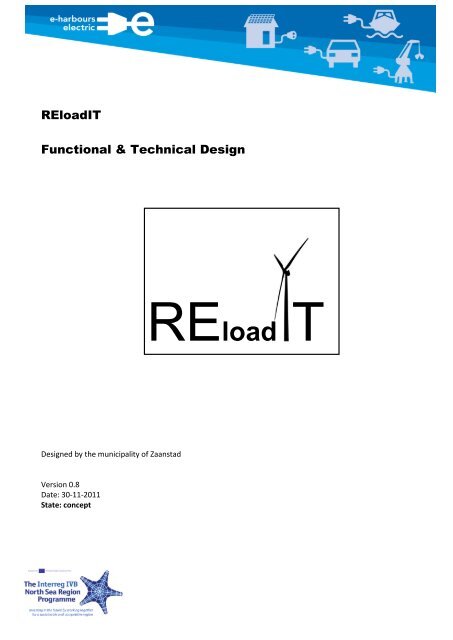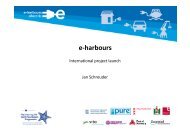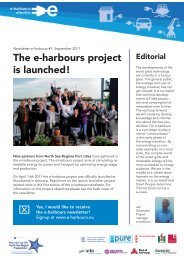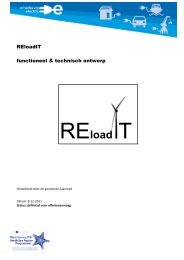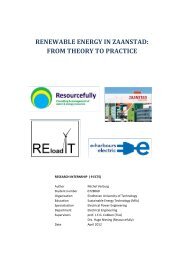Functional specification Smart Grid system - e-harbours
Functional specification Smart Grid system - e-harbours
Functional specification Smart Grid system - e-harbours
Create successful ePaper yourself
Turn your PDF publications into a flip-book with our unique Google optimized e-Paper software.
REloadIT<br />
<strong>Functional</strong> & Technical Design<br />
Designed by the municipality of Zaanstad<br />
Version 0.8<br />
Date: 30-11-2011<br />
State: concept<br />
REload T
Contents<br />
2<br />
Content 2<br />
Figures 2<br />
<strong>Functional</strong> <strong>specification</strong> <strong>Smart</strong> <strong>Grid</strong> <strong>system</strong> 3<br />
Introduction 3<br />
Basic features <strong>Smart</strong> <strong>Grid</strong> <strong>system</strong> 4<br />
Design strategy business agent 4<br />
Visualisation 5<br />
Data processing and reporting 5<br />
System architecture 7<br />
Software architecture SG-<strong>system</strong> 8<br />
Scope of work en deliverables 9<br />
Completions 9<br />
Materials 9<br />
Documentation 9<br />
Activities 9<br />
Maintenance and guarantees 9<br />
Quality Assurance 9<br />
References 10<br />
Attachment: Elaboration functional <strong>specification</strong>s 11<br />
Figures<br />
Figure 1: Proces flow schema van het SG systeem ............................................................................................. 3<br />
Figure 2: Concept systeemarchitectuur REloadIT ............................................................................................... 7<br />
Figure 3: Concept software architectuur c.q. proces data flow ReloadIT ........................................................... 8
<strong>Functional</strong> <strong>specification</strong> <strong>Smart</strong> <strong>Grid</strong> <strong>system</strong><br />
Introduction<br />
A <strong>Smart</strong> <strong>Grid</strong> <strong>system</strong> (SG) consists of a cluster of multiple independent energy sources and energy users, who<br />
share energy and information through an electricity and ICT network respectively. The purpose of a SG is, on<br />
the basis of a specific business case, to use consumption of electricity and sustainable energy production in<br />
an optimized way. Examples of business cases are: peak shaving, i.e. to improve the power profile of the<br />
distribution network by moving the profiles of the various users and producers. This reduces the peak<br />
consumption and the lowers the impact on the distribution network. This peak can also be avor something<br />
comparableed in the contract fees. Another business case is to financially benefit by offering flexibility<br />
(valleys and peaks in power consumption) to the <strong>system</strong> operator. In the framework of this project the main<br />
goal is to use of the available sustainable energy for the benefit of the electric transport in an optimized way.<br />
Figure 1 shows a schematic representation of the intended SG-<strong>system</strong> in the form of a process flow scheme.<br />
3<br />
Device Agent<br />
PV systeem<br />
(3)<br />
Divice-Agent<br />
Laadstation<br />
(of per<br />
laadpaal?)<br />
Figure 1: Proces flow schema van het SG systeem<br />
Device Agent<br />
Wind turbine<br />
Priority manager<br />
Busines Agent<br />
Meteo<br />
service<br />
The SG-<strong>system</strong> has a hierarchical structure and is composed of a Priority Manager, a Business Agent, and 1 or<br />
more Agent-devices. In a more extended SG-<strong>system</strong> there can be multiple Priority Managers be included. In<br />
the context of this project due to the small size of the cluster 1 Priority Manager is sufficient.<br />
The Agent-devices sign up at the Priority Manager. For each device (the source of energy or an energy user:<br />
charging station and solar installations) the Device Agent calculates the priority, this determines the choice<br />
of the device to consume or produce energy again. The Agent-devices give this information to the Priority<br />
Manager. The business agent interprets the business rules in combination with the weather forecast, and<br />
sends it to the Priority Manager.<br />
This Priority Manager in turn calculates the asset allocations per device, based on the information retrieved<br />
from the device agents and the business agent. The allocations are then given back to the Agent-devices. The<br />
entire <strong>system</strong> per time slot rotates cyclic: the business case of e.g. 15 minutes passed and information<br />
exchanged. In this case should be to maximize the energy yield of 3 solar installations and future wind<br />
turbine for electric transport. The business rules (or line strategy) are described in the next chapter.
Basic features <strong>Smart</strong> <strong>Grid</strong> <strong>system</strong><br />
Design strategy business agent<br />
Managing the load of the SG will take place on the basis of the rules established by the Business Agent be<br />
passed:<br />
1. Maximum the use of the available solar energy (and later also the wind energy). I.e. charge vehicles with<br />
to the maximum daytime loading state of charge with renewable energy. The surplus of electricity is<br />
delivered back to the municipality of Zaanstad through the distribution network.<br />
2. Take advantage of difference in tariff between the day and night if the renewable energy predicted for the<br />
day is insufficient.<br />
3. The state of charge of the 16 vehicles should be guaranteed using the user parameters such as: the<br />
scheme with driving times, the desired minimum driving distance, and the time interval on which the<br />
vehicles should be available. Alternative: the charging station if 1 large battery. Here IMTECH information is<br />
still required.<br />
4. If possible: Delivering energy back to the grid by the batteries if there is a surplus based on the planned<br />
transport by the vehicles.<br />
ICT infrastructure<br />
For the benefit of communication and linking of peripheral devices to the SG-<strong>system</strong> serves an ICT network<br />
needs to be available. In the chapter <strong>system</strong> <strong>specification</strong>s, the <strong>specification</strong>s of this ICT infrastructure are<br />
further elaborated.<br />
Data-acquisition and control<br />
An important central part of the SG-<strong>system</strong> is the periodically viewing and controlling (if necessary<br />
modifying) of all the parameters of the Agent-devices. We distinguish the following components:<br />
1. The 3 PV installations, (type inverter? Interface Specification? Information required from Zaanstad).<br />
2. The charging station, upgradeable to a maximum of 32 loading piles, (type? Interface? Here IMTECH<br />
information is required).<br />
3. The wind turbine (s).<br />
4. Interfaces with external <strong>system</strong>s such as the meteo-server for the weather forecast.<br />
Data storage <strong>system</strong><br />
The function of the data storage <strong>system</strong> is to secure all relevant data as a source to analyse the data of the<br />
SG-<strong>system</strong>. This information can then serve again to learn and improve the REloadIT SG <strong>system</strong>.<br />
Besides that it serves as a source of information for the reporting tools, and the (web) applications with<br />
which the data can be shown to the public. The data is regular be saved, at least once per 15 minutes.<br />
4
Visualisation<br />
Results of the measurements are compressed and displayed on a graphic display via a Web application<br />
(whether or not publicly available).<br />
For example: a publicly available web-display with information about "sustainable transport Zaanstad" which<br />
shows:<br />
• The percentage or number of kilometres driven on renewable energy.<br />
• Week production of the PV installations and wind turbines versus current meteorological data.<br />
• State of charge of the batteries.<br />
• Equipped with the logo of e-<strong>harbours</strong>, Zaanstad, Interreg, REloadIT.<br />
• In addition, explanations about relationship between the weather, the sustainable energy generation, and<br />
the electric transport.<br />
• Information per automobile or user. What is possible with the current loading pole <strong>system</strong>?<br />
Data processing and reporting<br />
The source of the data processing and reporting is the data storage <strong>system</strong> in the form of the database (SQL<br />
server or mySQL or something comparable). The database should be accessible via an open interface (such<br />
as ODBC).<br />
Reports can be carried out using standard tools such as MS Access and Excel. There is no need for the<br />
development for special applications.<br />
5
System <strong>specification</strong>s<br />
Principles <strong>system</strong> design<br />
1. The <strong>system</strong> should preferably be scalable, implying that by extension of an existing type energy supplier or<br />
user this is possible without reviewing the entire platform. Let´s see what is and is not feasible. The <strong>system</strong><br />
should be scalable in the sense that the <strong>system</strong> is expandable: the interfaces between the equipment within<br />
your own standard should preferably be uniform. The intention is that later, wind turbines and WKO (heat<br />
cold storage) and maybe pumps can be included in the business case.<br />
2. The equipment shall be preferably wireless exchange information.<br />
3. The SG-<strong>system</strong> is preferably platform independent. Windows and Linux is allowed although for desktop<br />
data processing a link with Windows is required.<br />
4. All stored data should be accessible in a database, accessible via an open interface such as ODBC.<br />
5. Determination of the hardware environmental <strong>specification</strong>s such as location, housing, temperature,<br />
humidity, dust etc. TBD<br />
6. Choice hardware for the MMI (man machine interfaces). Whether or not to use local displays.<br />
7. Local power supply: a UPS with a capacity of approx. 30 minutes to disable the <strong>system</strong> checked himself.<br />
8. Failure of the ICT infrastructure should the charging station and the solar installations continue to work<br />
autonomously.<br />
9. Dial-up facility for maintaining the <strong>system</strong> (VPN, in consultation with ICT service Zaanstad). nice to have<br />
6
System architecture<br />
The base platform is composed of the following components (see Figure 2: Concept REloadIT <strong>system</strong><br />
architecture):<br />
7<br />
Agent device<br />
laadstation<br />
Laadstation<br />
Console laadstation<br />
Agent device<br />
PV systeem (3*)<br />
Internet<br />
VPN<br />
Publieke web applicatie<br />
Figure 2: Concept <strong>system</strong> architecture REloadIT<br />
Agent device<br />
Windturbine<br />
Fire wall<br />
RF router<br />
Workstation gemeente Zaanstad,<br />
<strong>Smart</strong> <strong>Grid</strong> server<br />
GUI reserveringssysteem<br />
LAN Zaanstad<br />
Extern: Meteo server<br />
1. A central Workstation (IPC or something comparable), which established the coordinating role of the<br />
total <strong>system</strong>, and database, and the web application (s) serves.<br />
2. The charging station of Imtech (type? Here IMTECH information is still required).<br />
This station is equipped with an Ethernet or wireless interface through which information can be<br />
exchanged with the Workstation through a specific protocol. Minimum requirements are: the<br />
<strong>system</strong> should be without customization in the design or in the software are suitable for a maximum<br />
of 32 loading points.<br />
3. Control console for the car users (is this possible given limited intelligence cars? To fill in more detail:<br />
location, features, ….)<br />
4. 3 solar installations on 3 independent locations. The plants each have a inverter that convert solar<br />
energy into electrical energy and inject on the 220 Volt distribution <strong>system</strong>. The inverter also<br />
contains an interface (Brand type and type of interface naming), with which it can communicate to<br />
the <strong>Smart</strong>grid-platform real-time yield of the Panel read out. (Shows the inverter in a closed space<br />
produced or outdoors?).<br />
5. A display panel that is being drafted in the town hall for the view of the main results of the <strong>system</strong><br />
(further to be specified during implementation). Display with Web application (Central Workstation<br />
on which the SG-can software runs).<br />
6. Meteo interface: link to a real or simulated interface with a weather forecasting <strong>system</strong> used for<br />
predicting the yield of wind and solar energy in the SG-<strong>system</strong>.<br />
7. A link with the car reservation <strong>system</strong>. Further define (e.g. a link with Outlook that the 16 cars can be<br />
scheduled).<br />
8. A backup <strong>system</strong>: of the measuring data and parameters should be backed up once a week.
Software architecture SG-<strong>system</strong><br />
Figure 3: Concept software architectuur c.q. proces data flow ReloadIT<br />
Explanation and design considerations on behave of the scope will follow.<br />
8
Scope of work en deliverables<br />
Completions<br />
Materials<br />
All components such as described in the previous paragraph, and to the extent not explicitly indicated, all<br />
necessary components to complete working <strong>system</strong> to deliver.<br />
Operational costs and consumables such as communications and internet costs, travel and subsistence costs,<br />
etc…<br />
Not within the scope of these <strong>specification</strong>s : the loading pole infrastructure and ICT infrastructure at least<br />
the fixed network.<br />
Documentation<br />
Documentation package consisting of the following components:<br />
1. Quality plan software or <strong>system</strong> development (extract).<br />
2. Test plan or factory and site acceptance test (FAT and SAT) for the SG-<strong>system</strong>.<br />
3. Electrical drawings of the hardware, especially the interfaces with the infrastructure and peripherals<br />
(as built).<br />
4. Basic design software (as built).<br />
Activities<br />
1. Design and development of the SG <strong>system</strong>.<br />
2. Operation of the <strong>system</strong> on behave of a SAT plan designed by the contractor<br />
3. Operational maintenance of the entire <strong>system</strong> until 31-12-2013.<br />
4. The provision of data to the end users through authorization <strong>system</strong> of the Zaanstad. and data<br />
format accessible through the Central drafted Workstation and database.<br />
5. Manual control functions charging pole<br />
6. Technical documentation where relevant for the end users and maintenance of the <strong>system</strong>.<br />
Maintenance and guarantees<br />
1. Keep the entire <strong>system</strong> operational during the period of the project contract of delivery until 31-12-<br />
2013.<br />
2. Contacting a disturbance within 3 working days through a contact person (account manager project<br />
or building administrator), and solving a disturbance withing 7 working days. TBD<br />
3. Failure of seller to replace the ICT equipment during the turnaround time of the project contract.<br />
Property rights<br />
The supplied equipment is owned by the municipality of Zaanstad.<br />
The software supplied, at least the binary executables or objects are owned by the municipality of Zaanstad.<br />
The IP of the VPP-software and the source code of the software are the property of the contractor.<br />
Quality Assurance<br />
The quality aspects include the following aspects:<br />
1. safety equipment must all comply with the CE marking requirements for Electrotechnical equipment.<br />
2. contractor has the right to perform design reviews before proceeding to the actual implementation.<br />
3. Site acceptance testing of the <strong>system</strong> and part <strong>system</strong>s are carried out by the contractor and client a<br />
jointly drawn up by the contractor and obv by the Zaanstad approved test plan.<br />
4. the contractor must prove that they work according to a quality <strong>system</strong> including development<br />
methodology, test procedures, and a part version control <strong>system</strong>.<br />
9
Planning<br />
See also the project plan (Ref 1). Within that framework, we distinguish the following phases and milestones:<br />
1. Define <strong>system</strong> requirements and user requirements to be approved .<br />
2. Review basic design <strong>system</strong> design of awardee by Zaanstad .<br />
3. Understand the prior design detail<br />
4. implementation<br />
5 hardware and software deployment. Decrease test <strong>system</strong>, and the functional and <strong>system</strong> <strong>specification</strong>s<br />
part <strong>system</strong> obv.<br />
6. installation on location<br />
7. Decrease test on location<br />
8. Acceptance total <strong>system</strong><br />
9. Commissioning total <strong>system</strong><br />
10. Maintenance of the <strong>system</strong><br />
11. Evaluation and adjustments (outside this scope and post-calculation obv).<br />
To mile stone 9 is the turnaround time 4 months, counting from ordering to delivery.<br />
References<br />
Ref 1 Project plan REloadIT<br />
Ref 2 Specification IMTECH interface<br />
Ref 3 Specification PV-inverter ???<br />
10
Attachment: Elaboration functional <strong>specification</strong>s<br />
11


